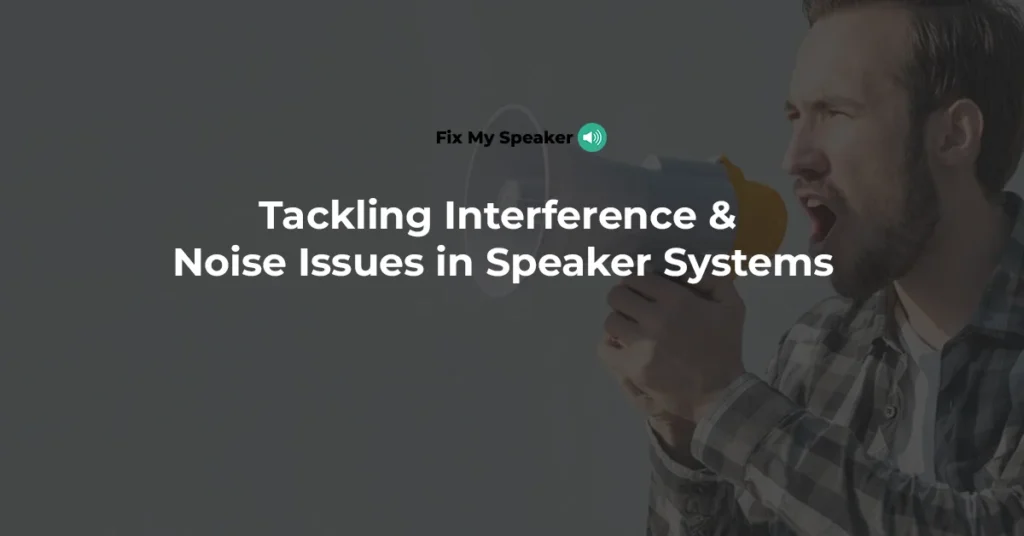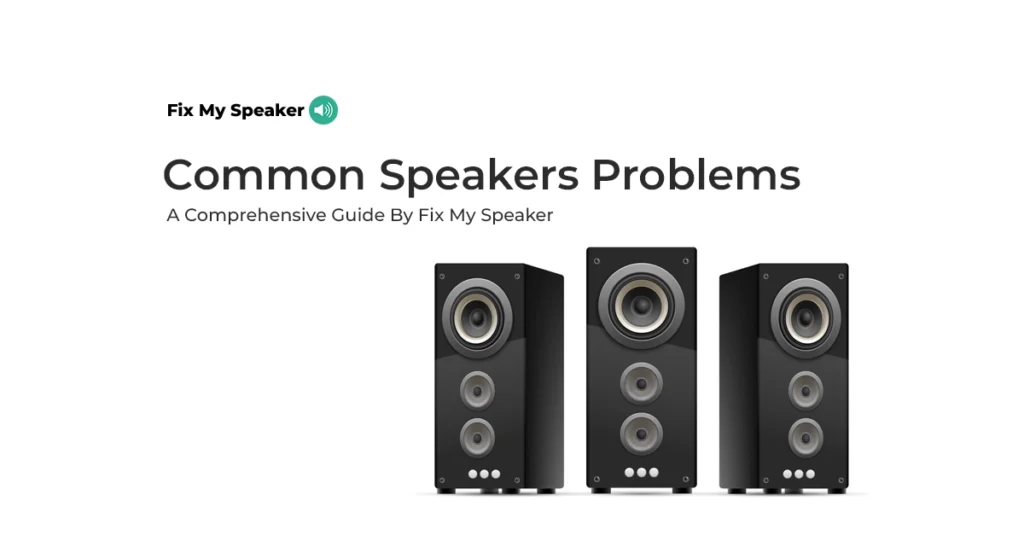Speakers are essential for experiencing high-quality audio, whether you’re listening to music, watching a movie, or engaging in a virtual meeting. However, interference and noise issues can significantly degrade the listening experience, leading to frustration and decreased performance.
We’ll explore the causes of these issues and provide detailed, step-by-step solutions to help you eliminate them.
1. Understanding and Fixing Buzzing Sounds in Speakers
Buzzing sounds in speakers are a common issue that can stem from various sources. These sounds can be continuous or intermittent, and they often indicate an underlying problem that needs to be addressed.
Causes of Buzzing Sounds
- Electrical Interference: One of the most common causes of buzzing is electrical interference from other devices. This interference can occur when speakers are placed too close to power lines, fluorescent lights, or other electronic devices.
- Grounding Issues: Poor grounding can cause a humming or buzzing noise in speakers. This often happens when the grounding of the audio equipment is not properly connected or if there are issues with the power supply.
- Faulty Cables: Damaged or poorly shielded audio cables can pick up electromagnetic interference, leading to buzzing sounds. Loose connections can also cause this problem.
- Internal Component Failure: Sometimes, buzzing can result from internal components in the speaker, such as a failing power supply or faulty capacitors.
Step-by-Step Troubleshooting Guide
To fix buzzing sounds in speakers, follow these steps:
Identify the Source of Interference:
- Turn off all nearby electronic devices and see if the buzzing stops. If it does, the problem is likely due to electrical interference.
- Move the speaker system away from potential sources of interference, such as power lines, routers, or other electronic devices.
Check Grounding:
- Ensure that all audio equipment is properly grounded. Use a multimeter to check the grounding of the power outlet.
- If grounding issues are identified, consider using a ground loop isolator or connecting the equipment to a different power outlet.
Inspect and Replace Cables:
- Examine all audio cables for signs of wear and tear. Replace any damaged cables with high-quality, shielded cables to prevent electromagnetic interference.
- Make sure all connections are secure and properly seated.
Examine the Speaker’s Internal Components:
If the buzzing persists, the issue might be internal. Consult the speaker’s manual to identify possible component failures or consider taking the speaker to a professional for repair.
Use a Power Conditioner:
Power conditioners can help eliminate electrical noise by filtering out interference from the power supply. This can be especially useful in environments with poor electrical quality.
2. What Causes Speaker Humming and How to Eliminate It
Speaker humming is another common problem that can disrupt your audio experience. The hum is usually a low-frequency sound that persists even when no audio is playing. Understanding the causes and solutions for speaker humming is key to resolving this issue.
Explanation of Speaker Humming
Speaker humming is often a result of ground loop issues, where two or more pieces of audio equipment share the same electrical grounding but have different ground potentials. This difference creates a loop, causing a 60 Hz hum (in the US) or a 50 Hz hum (in other countries) in the speakers.
Common Sources of Humming
- Ground Loops: As mentioned, ground loops are the primary cause of humming. They occur when multiple devices connected to the audio system have different ground potentials.
- Transformer Hum: Transformers in audio equipment can also produce a humming sound, especially if they are of low quality or old.
- Inductive Coupling: When cables carrying an audio signal run parallel to power cables, they can pick up the 50/60 Hz hum from the electrical lines.
Methods to Diagnose and Fix the Issue
To eliminate humming sounds from your speakers, follow these steps:
Diagnose the Ground Loop:
Disconnect all components from the speaker system except the power cord. If the hum stops, the issue is likely due to a ground loop involving one of the connected devices.
Reconnect each component one at a time to identify the source of the ground loop.
Use a Ground Loop Isolator: A ground loop isolator can be inserted between the audio source and the speaker to break the ground loop, thereby eliminating the hum.
Check Power Cables and Placement: Ensure that power cables are not running parallel to audio cables. If possible, cross them at right angles to minimize inductive coupling. Consider using shielded cables to further protect against inductive coupling.
Use a Hum Eliminator: Hum eliminators are devices designed to filter out the 50/60 Hz hum from audio signals. They can be placed between the audio source and the speaker to remove humming sounds.
Examine the Speaker’s Power Supply: If the hum persists, it may be coming from the speaker’s power supply. Consider using a different power outlet or a power conditioner to stabilize the power supply.
Isolate the Transformer: If the humming is coming from a transformer, consider replacing it with a higher-quality one or using sound-dampening material to reduce the noise.
3. Dealing with Feedback Issues in Speaker Setups
Feedback is a sharp, high-pitched sound that occurs when the speaker’s output is picked up by the microphone and re-amplified. It is common in live sound environments but can also occur in home setups.
What Feedback Is and Why It Happens
Feedback occurs when the microphone picks up the sound from the speaker, which is then amplified and outputted by the speaker, creating a loop. The loop increases in intensity, leading to the characteristic squealing sound.
Techniques to Minimize or Eliminate Feedback
Positioning of Microphones and Speakers:
- Place microphones as far away from speakers as possible to minimize the chance of feedback.
- Aim the microphone away from the speakers to avoid capturing the sound.
Adjusting the Gain:
- Reduce the microphone gain to prevent it from picking up excessive ambient sound.
- Use a compressor to control the dynamic range and prevent sudden spikes in volume that could cause feedback.
Using Directional Microphones:
- Directional microphones, such as cardioid or hypercardioid mics, are less sensitive to sound coming from behind them, reducing the likelihood of feedback.
- Use microphones with built-in feedback rejection technology for better results.
Applying Equalization (EQ):
- Identify the specific frequencies causing feedback using a graphic equalizer.
- Reduce the gain at those frequencies to eliminate the feedback without affecting the overall sound quality.
Using a Feedback Eliminator:
Feedback eliminators are digital devices that automatically detect and suppress feedback frequencies. They are highly effective in live sound environments.
Reducing the Number of Open Microphones:
- Limit the number of active microphones in a setup to reduce the chances of feedback.
- Use a gate to automatically mute microphones when they are not in use.
Conclusion
Interference and noise issues in speaker systems can significantly impact audio quality, but with the right knowledge and tools, these problems can be effectively addressed. From buzzing and humming to feedback.
Summary of Interference and Noise Issues
- Buzzing Sounds: Typically caused by electrical interference, grounding issues, or faulty cables. Solutions include checking grounding, replacing cables, and using power conditioners.
- Humming: Often due to ground loops, transformer hum, or inductive coupling. Ground loop isolators and hum eliminators are effective tools for resolving this issue.
- Feedback: Occurs when the microphone picks up sound from the speaker and re-amplifies it. Techniques such as adjusting microphone placement, reducing gain, and using feedback eliminators can help.
Preventative Measures to Avoid Future Problems
- Regular Maintenance: Periodically inspect and maintain audio equipment to prevent interference and noise issues.
- Proper Equipment Setup: Ensure that speakers, microphones, and other audio equipment are set up correctly, with careful attention to cable management and grounding.
- Use of Quality Components: Invest in high-quality cables, power supplies, and other components to minimize the risk of interference.


